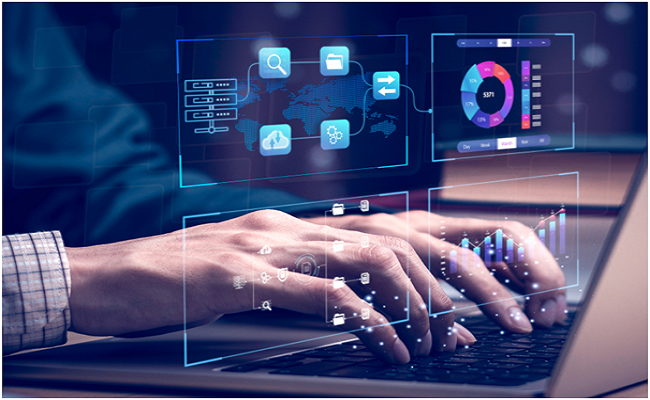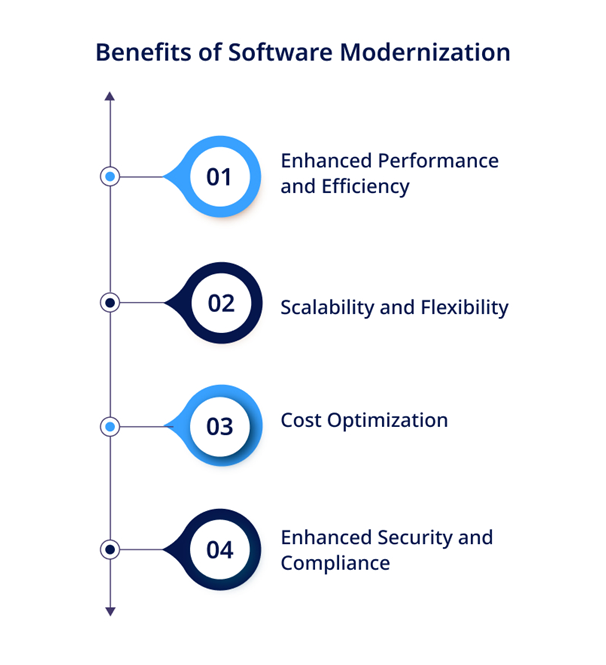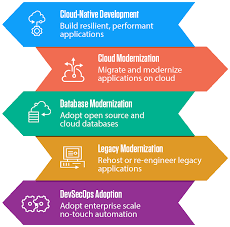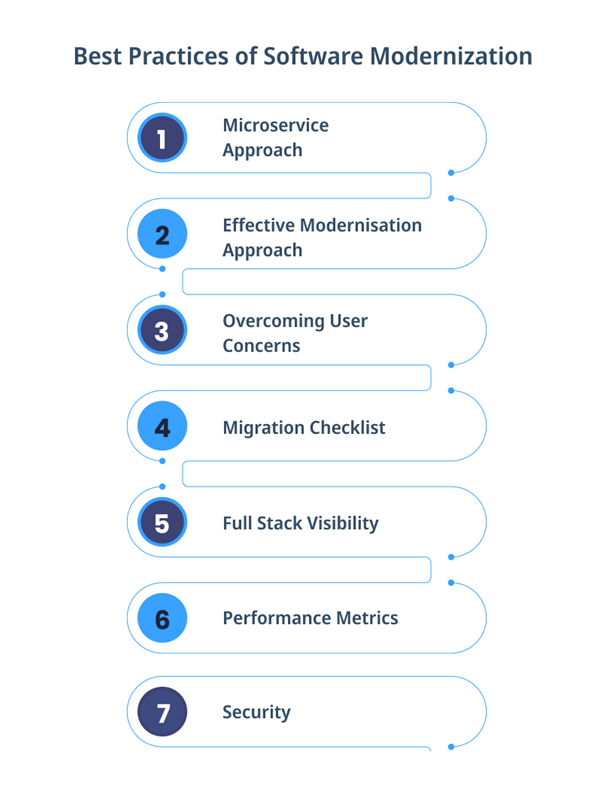Every industry is being forced to update its current processes and operational infrastructure as a result of the combination of modern technologies and constantly shifting market conditions. However, the majority of businesses continue to prioritise outdated applications, which may result in substantial losses.
Relying on core applications supported by an on-premises dedicated infrastructure restricts your growth and reduces the productivity of your entire firm. Sometimes it can even result in potential flaws, data inconsistencies, and other problems.
Software modernization is a feasible way to prevent such incompetency. In this article, we will discuss the key strategies and best practices of application modernization to help your company.
Why Is Software Modernization Essential?
Software modernization services are essential to maximizing technology's potential and stimulating innovation. Here are the major benefits of software modernization:
Enhanced Performance and Efficiency: Modernising outdated software results in noticeable performance gains. Outdated systems have common problems like ineffectiveness, frequent crashes, and slow reaction times. Businesses can optimize their software for greater performance, reliability, and resource utilization by implementing contemporary frameworks and technologies. As a result, productivity increases, downtime is decreased, and user experiences are better.
Scalability and Flexibility: The only way to survive and flourish in an environment where the global tech landscape is changing so quickly is to upgrade constantly. For a business to advance, face off against rivals, and generate more income, it must adapt and expand both physically and technologically.
However, it can be difficult to add new features or functionality to legacy systems. Businesses therefore want storage solutions that can adapt to their changing needs. It can increase or decrease their IT resources to handle heavier or lighter loads thanks to the scalability offered by the cloud.
Cost Optimization: Legacy systems can become financially burdensome due to high maintenance expenses, licensing fees, and ineffective resource utilization. By removing wasteful processes, cutting infrastructure costs, and optimizing operations, software modernization aids businesses in cost optimization.
Businesses can move away from capital expenditures to operational expenditures by utilizing cloud computing, paying only for the resources they really use. Furthermore, updated software requires less upkeep and assistance, freeing up funds for strategic efforts.
Enhanced Security and Compliance: One of the main reasons for updating the infrastructure of the legacy platform is security. Vendors don't support obsolete software, which eventually leads to malware attacks and data breaches.
A business entity benefits from modernization by having improved security and protection for crucial transactions. To defend against the most cutting-edge threats, it offers cutting-edge DDoS protection, security improvements, and Application Delivery Controllers (ADCs).
Users can employ bot management tools and secure web application firewalls to safeguard apps and data from hackers. Software modernization services guarantee adherence to industry laws and shield private information from unauthorized access. The danger of security incidents and data breaches is decreased by modernized software's ability to deliver timely security patches and upgrades.
Key Strategies of Software Modernization
Software modernization is a challenging task that requires careful planning and execution. Here are the main tactics you can use to complete this journey successfully:
1. Comprehensive Assessment
To begin the modernization process, extensively examine the current software landscape. Analyze the current state of the systems, identify any issues, and determine how much modernization is required. This assessment will help define precise goals and objectives for the modernization program.
2. Prioritization and Roadmap
Prioritize the systems and applications that require immediate modernization based on factors such as business value, criticality, and effect. Make a roadmap that outlines the progression, timetable, and deadlines for modernization projects. This modernization process will be thought out and implemented in stages.
3. Modernisation Strategy
Choose the most effective modernization technique based on the particular requirements of each system. Options include lift-and-shift, replatforming, refactoring, rearchitecting, and total replacement. Because each technique offers benefits and considerations, pick the one that best matches the modernization project's goals and constraints.
4. Agile and Incremental Delivery
Adopt agile methods to manage the modernization process successfully. You may continuously test, iterate, and adapt by breaking the modernization into smaller, more manageable jobs or iterations. This approach lowers risks, expedites project completion, and ensures stakeholder participation.
5. Collaborative Stakeholder Engagement
Collaborate with management, IT teams, and business users throughout the modernization process to involve important stakeholders. To ensure that the upgraded software meets their demands and adheres to organizational goals, participate in requirement collecting, user acceptance testing, and feedback sessions.
6. Testing and Quality Assurance
Confirm the upgraded program's performance, security, functionality, and compatibility using a well-thought-out testing strategy. User acceptance testing, system testing, integration testing, and unit testing are all included in this. Prioritize thorough testing to identify any issues or weaknesses and solve them before releasing the new program.
7. Data Migration and Integration
When modernizing, pay particular attention to data integration and migration difficulties. Ensure a quick and secure data movement from outdated systems to newer applications. Use processes for data mapping, transformation, and validation to maintain data consistency and integrity.
8. Training and Documentation
To ensure a smooth transition to the new program, provide the required training and documentation to end users, administrators, and support teams. This lowers disruption, hastens acceptance, and gives users the tools to employ the updated software's capabilities and features.
9. Monitoring and Maintenance
Once deployed, create monitoring procedures to monitor the upgraded program's behavior and functionality. Utilise preventative maintenance strategies to address issues, roll out updates, and ensure continued performance and dependability.
10. Continuous Improvement
Software modernization is an ongoing activity instead of a one-time event. You may encourage a culture of continuous improvement by asking for feedback, looking at performance indicators, and finding opportunities for new enhancements and optimizations. Check the updated software frequently to ensure that it continues to meet evolving business requirements.
Software Modernization Best Practices for Business Growth
Businesses must create seamless apps that offer dependable, secure, scalable, and integrated solutions in the rapidly changing modern environment. Businesses must adhere to software modernization best practices to strengthen and equip themselves to fulfill customer demands.
1. Microservice Approach
The microservice approach is one of the techniques. Making an application into smaller, independent service apps makes the modernization process easier to accept. The services may be scaled more quickly and have their own logic and database.
2. Effective Modernisation Approach
Depending on how complex the legacy application is, the business must choose which modernization technique is most effective and can be used while taking into account variables like time, cost, scalability, and technology. The program can be updated in a number of methods, such as through re-architecture or restructuring, rewriting, ripping, replacing, or rehosting.
3. Overcoming User Concerns
Users are typically wary of change and apathetic about it, and application modernization is no exception. Since they are accustomed to utilizing the program every day, modernization forces them to adjust their working style, which pushes them outside of their comfort zone.
Therefore, it's crucial to clearly convey the need for modernization while outlining the advantages that these modifications will bring about when the program has been updated and modernized. Each modification should provide instructions on how to use it to get the most out of the system and get better results.
4. Migration Checklist
Modernization involves planning, not just shifting apps to the cloud. The amount of data in legacy systems must be known by the organization, along with which data and how much of it. Companies can transmit data more easily by documenting and developing checklists.
Additionally, it's important to consider the format required, how the data is represented, and how it may be transferred to the new system. In addition to testing to make sure the transferred data is precise, pertinent, current, and consistent.
5. Full Stack Visibility
Modernized applications require interaction with legacy systems. It is crucial to have full visibility of these applications on the cloud. By monitoring performance from the end-user's point of view, full-stack visibility enables the early detection of potential difficulties and problems.
6. Performance Metrics
These metrics are used to monitor the entire infrastructure, from networks and databases to the cloud, as well as to track application performance down to the code level. Companies can detect faults, issues, and areas that require additional work by using performance analytics.
7. Security
Legacy programs typically have low-security levels, which must be rectified to prevent problems with organization-wide security. A key necessity for the modernization of apps is the attentive integration of security at each level of the process. It is crucial to combine data encryption with strict authorization protocols and access limits.
Final Words
Software modernization services help organizations stay competitive and adapt to changing customer needs in real-time. Even while starting the process of modernizing your software product journey may seem intimidating, it's an essential step in the right direction.
We hope that with the above-mentioned approach, software product modernization can be a smooth and rewarding journey that will transform your business and you can experience the best software development services.
If you’re unsure where to start or have hit a roadblock in your attempts to modernize, contact technology partners. Connect with software development companies or hire software developers to make your product more efficient, user-friendly, and scalable.




